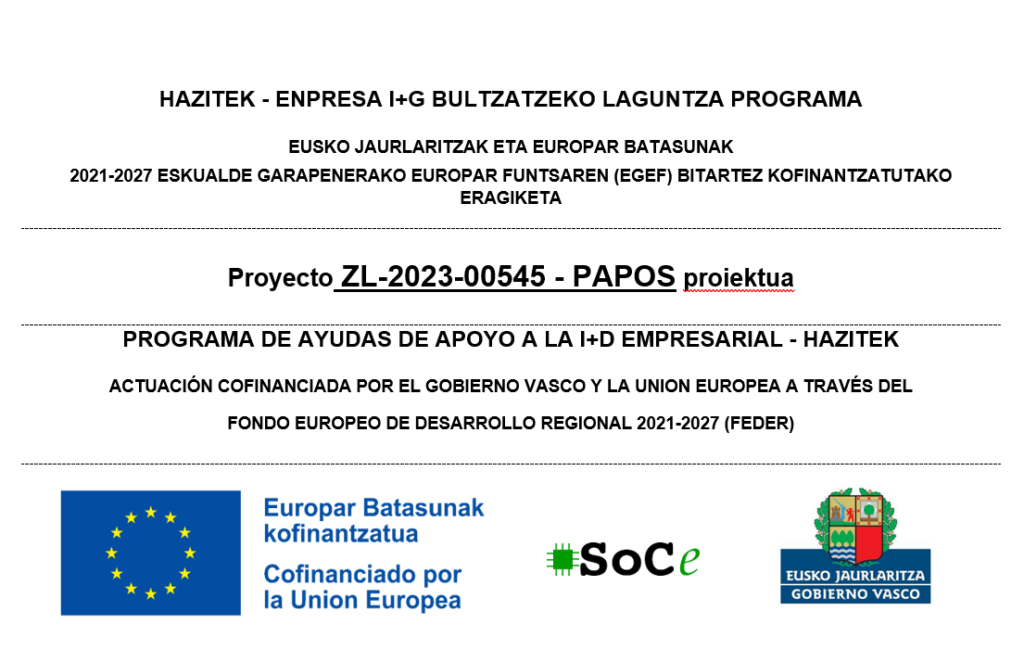We have R&D in our DNA and that’s why the Basque Government has recently awarded us a grant within the Hazitek grant programme.
This is the PAPOS Project: design and development of next-generation Ethernet communications technology and product that can be integrated into aerospace platforms.
The national electricity grid is made up of more than 44,000 kilometres of high voltage lines, more than 6,000 substation positions, more than 93,000 MVA of transformation capacity (Red Eléctrica, 2023) and continues to grow. In it, electricity generation systems and consumers have been changing over the years to adapt to the evolution of technology, yet day-to-day electricity transmission seems to be immune to time because of the difficulties involved in this type of facility itself, making it costly and complex to maintain. Some examples of these difficulties are the infinite number of sensors wired with copper, power cuts that affect customers and penalise the sector, necessary resources (machinery and personnel transferred to this type of installation, which are usually remote), or tests with real power injection (electrical risk).
For some time now, engineering has had the necessary means for a paradigm shift. The main focus of the digital substation is the digitisation of communications, the management of information through data networks and the development of detailed engineering and remote control. All this is driven by a regulatory framework under the IEC 61850 standard (TC 57, 2009-2022) which has, among others, the objectives of improving process automation and ensuring interoperability between different electrical equipment and command and control systems, gaining in management efficiency.
The IEC TR 61850-10-3 standard (TC 57, 2022) defines services and solutions that seek to ensure this automation and, above all, interoperability, i.e. the ability to exchange information between equipment from different manufacturers by defining a common language and a standardised data model and communication services that enable the creation of an automatic protection, diagnosis, monitoring and remote control system.
In this scenario, there is no longer any room for power injection or measurements via copper cables, as all these analogue signals are replaced by digital data packets. In this context of opportunity, it is necessary to innovate in the testing process of Automation, Protection and Control Systems (SPACS) and to optimise the validation processes in multiple situations: after a software update process, for maintenance, during a start-up, after the restoration of service following a fault, for the extension of positions, etc. The main objective of the PAPOS project is to develop a portable HW equipment with a web interface accessible in a cybersecure way, capable of developing remote tests according to the needs of the digital substation. Some actions that will evolve with digitalisation within these tests can be emulating and checking standard signals, injecting voltage or current, manual verifications, drives, etc. For this, the equipment must be able to perform tests at station bus and process bus level.
- The equipment must be embedded in a robust device capable of connecting to redundant ethernet networks and with IEC 61850-based publisher, subscriber and client capabilities, which translates into a high-capacity FPGA and CPU. For communications it needs to have Redbox functionality and support HSR (TC 65/SC 65C, 2021) and PRP (TC 65/SC 65C, 2021) protocols.
- The equipment must be an MMS client, must be able to emulate SV signals, GOOSE and MMS reports and must be able to be configured according to SCL files. It must also have JavaScript test templates that can be created, edited, imported and exported and the tests must be able to be launched continuously or step-by-step.
- The equipment must be able to synchronise with the network according to IEEE 1588-2008 Precision Time Protocol (PTPv2), support Transparent Clock and Ordinary Clock modes of operation, operate in the Power profile defined in Profiles: Default, Power, IEC 61850-9-3 and support Simple Network Time Protocol (SNTP).
- In terms of security, there must be role-based access control and each role must have specific and validated permissions against remote LBAC server in the first instance or local RBAC.

